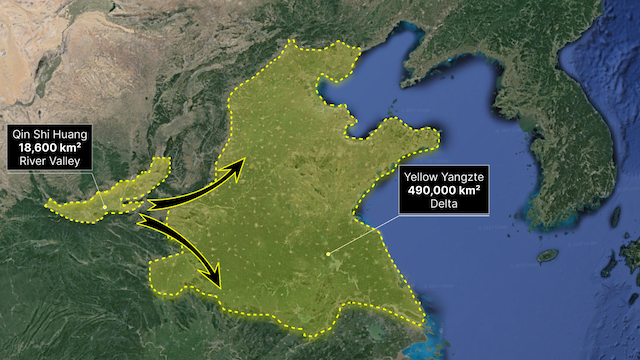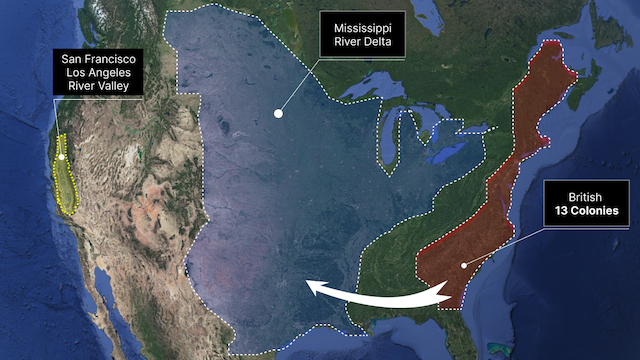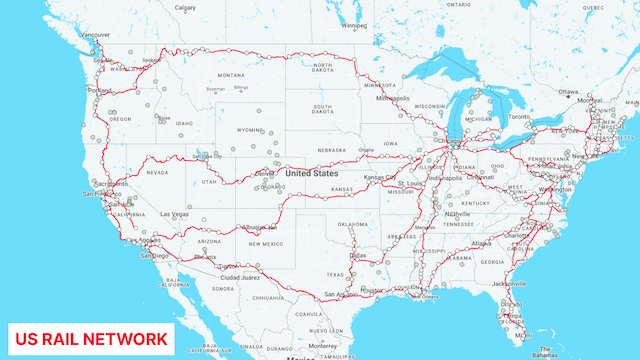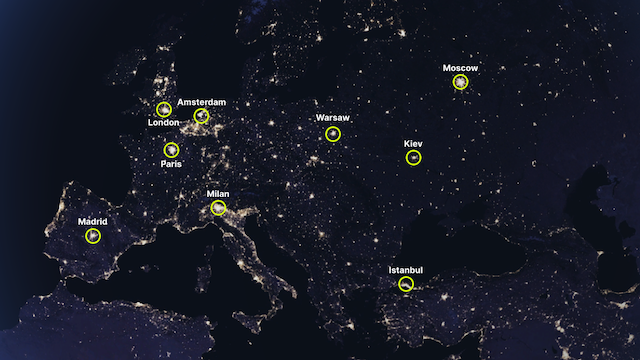Qin Dynasty and The Founding of United China
The valley of Xian was the birthplace of modern China. The valley does look like the mother womb with one way in and plenty of water supply from the Weihe River, the largest tributary of the Yellow River but without the high speed current and flooding from the Yellow River.

The geographical position of the Qin dynasty allowed it to have a small advantage at the beginning of the Warring period in consolidating resources and manpowers while only having to fight a single front war.

Xian elevation of 405 meters above sea level also gave it major advantages in defending its territory. Sitting on its medium size delta but large enough to feed an upstart nation, Qin Shi Huang exhausts armies after armies at the time of foot soldiers and horses before launching a major offensives taking over the majority of modern China.

Even though the Qin dynasty only lasted for 15 years, Qin-invented Injection Molding method has enabled the empire to mass manufacturing its weapons and currency hence unifying the Yellow-Yangzte river delta under a single currency, weight, measure and writing systems.

With a single collaboration protocol, Qin dynasty was able to direct resources across its newly consolidated but fragile empire to go after few single infrastructure projects like the Great Wall of China to fortify the Northern front and the Lingqu Canal connecting Yangtze River and the Pearl River to enable continuous offensive campaigns toward the South.

With existing infrastructures of information and transportation built under Qin Shi Huang, the multi-ethnics and multilingual fragmented warring states of China was replaced by a single concept of Han ethnics and Han language.

US Dollar and The Founding of United States of America
With the leading edge advances in shipbuilding, mapping and ocean navigation, the British and Portugal navies were dominating the ocean around the globe at the beginning of the 17th century, defeating the coalition of major land power France and Spain in naval wars along the North Atlantic sea lanes as well as the British home island.

After the Anglo-Spanish war of 1762, The British and Portugal victory enabled them to have a larger share of the American continent and established the modern day United States in North America and Brazil in South America.

The British navy enabled the British Crown to protect the sea lane connecting the Island of Britain with the North Atlantic coastline of the American continent and establishing shorter and less vulnerable trade routes with its colonies than the Spanish and the French.

By continuously supplying its 13 colonies with fresh explorers and ammunition as well as establishing a positive cycle of trading with its 13 colonies, the business of colonizing the massive North America landscape became extremely profitable.

The colonial population grew from about 2,000 to 2.4 million between 1625 and 1775, displacing Native Americans. Large part of this increase in Colonial population comes from African slaves being shipped from Africa to North America for labor.

The African slaves population separated from their tribes, with little ability to organize and collaborate now working in a strange new land that they have no knowledge of terrain or navigation would make a more obedient worker population than the hostile redskin Native American.

And then in 1775, with the help from the previously defeated French navy, a British general George Washington started a coup in the yet still far-away 13 colonies of Britain and established the independent United States of America.

The semi-independence of the United States of America from the British Crown started the English populization as the Colonial languages for all North America, India, Malaysia, Singapore, Philipine and Australia, a human resources first natural resources second hand-off approach to British colonial management.

The eloquent piece of American declaration of independence is being copied and reprinted around the globe in English and translated into different languages. American English is now cool even to the defeated Spanishes, the African slaves or the Native American chieftains.

After the American Spin-Off from the British empire, now they can trade with all European colonial powers, accept immigrants from all European countries, not just Britain and her allies. The United State of America with a quiet North Atlantic coastline now can also use its own surplus resources toward its military and infrastructure development to expand toward the West while British Empire expanding toward the East.

The expansion of American territorial from 1st first 13 East Coast colonies toward the entire modern United States spanning from the North Atlantic to the North Pacifics go hand in hand with large influx of European migrants, the massive increase in number of Mustang horse population, a single common US currency for all colonies and the construction of the first transcontinental railroad connecting US Eastcoast to San Francisco, California.

Within 150 years or 3 generations of migrants, the US economy would grow from a tributary colony to the largest economy in the world prior to World War 1. During WW1 and WW2, even more talented scientists, doctors and wealthy families fleeing the destruction of wars in Europe, migrating to the United States like Albert Einstein or Nicholas Tesla.

And after the defeat of Japan in the battle for the Pacifics, the US currency became the foundation of global modern finance. Every move from the FED chairman would set the rhythm for the entire global economy.

The Founding of EU, The EURO and European Central Bank
During WW2, only 3 countries had a functional war economy: Germany, Japan and the United States while every other country was the battlefields or colonial resource extraction sites.

The war economy production of nazi germany for the first time create a large scale multi-countries resource pooling for heavy industry manufacturing from all German occupied countries. With the European Coal and Steel Community founded in 1951 and the European Atomic Energy Community in 1957, French and German leaders were trying to recreate the scale of a War Economy during peacetime in Europe.

Both Napoleon and Hitler were failed at uniting Europe into a single union using brute force like the way things have always been done over previous centuries. Will the paper and pen contractual approach be able to glue the European Union of multi-ethnics, mult-linguals countries together.

European countries can not erase their thousand year history of conflicts, cultures, languages and traditions like the way Qin Shi Huang did and Hitler tried to do via their book burning campaigns. All European countries can not have a common history and a common identity like the way Han Chinese and Americans have even though a few generations ago they were very distinct ethnics groups. Things were always impossible until it got done the first time.

Even though European have their differences, they were also advanced economies with access to high value products being built using the same common inputs: high density energy sources like coal, oil, gas and nuclear materials, highly refined material sources like cotton, steel, carbon fiber, high protein food sources like beef, salmon and soybean, highly clean water and air, highly specialized training in Science, Medicine and Finance.

The cars could have different brands but also run on the same gasoline, the clothes could look different but they are made from cotton, the meat could be cooked differently but they all need to be made from healthy well fed cattles. This common high standard of living across majority of European Union did not happen overnight after the carpet bombing and destruction of World War 2. After WW2, West Germany and France led the reconstruction of European countries but this time the tank and plane assembly lines were replaced by the BMW and Mercedes car assembly lines.

The Autobahn style highways were adopted across European countries. From 1960 to 1980, we saw an explosion of personal freedom and mobility across US, Western Europe and Japan with the adoption of cars as personal vehicles for every common man and woman. High level of personal mobility via highway system and high car ownership helps European nations and US to out maneuver and compete with a more rigid model of the So Viet Union.

By the 1980, Germany and Japan once again became top economies in the world with car brands like BMW, Mercedes, Toyota, Nissan, Suzuki, Mazda and Honda running everywhere on American, European and even Russian highways. European Union citizens also have access to much more energy per capita than in other areas in the world thanks to their proximity to the Middle East oil fields, and the multi-nations research and development of Nuclear Energy. By 1986, the majority of France's energy production came from Nuclear power plants.

After defeating a common enemy, the SoViet Union in 1990s, European Union become an even stronger Union with the creation of the EURO, a common currency for all EU members in 1992 and the creation of a no-border check Schengen Area. Now EU member citizens can spend their common currency anywhere within the Schengen Area, use the same driver license to travel to other EU member countries, work, buy houses and retire anywhere within the Schengen Area.

Goods can travel freely within EU member states with no tariff, and energy can be optimized via a common electricity grid.

Now university researchers, doctors, engineers and businessmen can use the internet for knowledge sharing and trades. And then meet up in person via a few hours car or train trip to collaborate and close deals. Experimental components could be shipped from one country to another without delays or extra fees.

The European Union also has their Qin Shi Huang megastructure project type with the construction of The Large Hadron Collider, the largest machine built by humans on earth. The Large Hadron Collider is so massive that it crosses the border of two countries: France and Switzerland and becomes a brain magnet that attracts the best minds in particle physics, engineering and tunnel building from all around the globe to work in Europe.

However, is the EU a perfect union like the US or China? European councils did not have the same level of control over local economies as the US Fed or China Central Bank so will the EU Bonds will ever be as reliable as the US Treasury Bond or China Real Estate.

EU member states will not likely invade each others but will they launch nuclear weapons or fight as a well integrated forces in the face of outside aggression. The European paper and pen Union still look quite fragile in the case of member state default or invasion.
